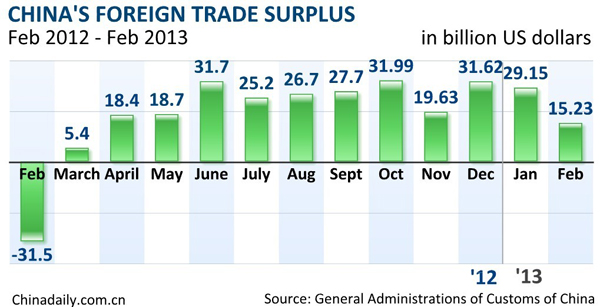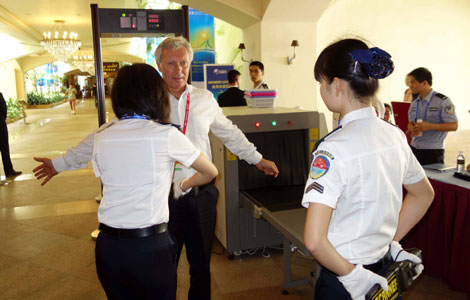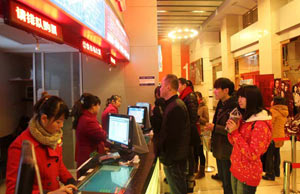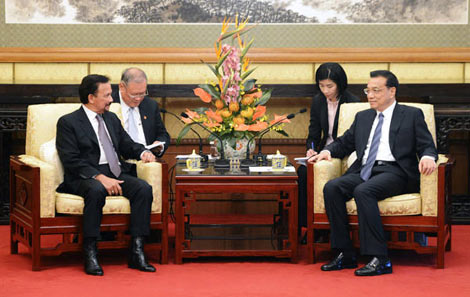

BEIJING -- China's foreign trade showed stronger signs of recovery buoyed by the upbeat demands from the United States and the emerging markets.
Exports increased 21.8 percent year-on-year to $139.37 billion in February, while imports fell 15.2 percent to $124.12 billion. the General Administration of Customs (GAC) said Friday.
Trade surplus expanded to $15.2 billion from a deficit of $31.98 billion a year earlier.
The GAC said that after taking seasonal factors into account, such as February's Spring Festival holiday, exports rose 20.6 percent and imports climbed 6.5 percent.
Wang Jun, an economist with the China Center for International Economic Exchanges, attributed the better-than-expected exports to the steady recovery of the Chinese, US and emerging economies.
The less-robust imports were due to a stronger US dollar and falling prices for commodity goods. Importers also replenished inventories before the Spring Festival, he said.
China's economic growth eased further to a 13-year low of 7.8 percent in 2012 from 9.3 percent in 2011 and 10.3 percent in 2010.
The government is targeting economic growth of 7.5 percent this year to leave room for economic restructuring.
It also hopes to increase its total foreign trade volume by around 8 percent amid a slow global economic recovery and rising trade protectionism.
A string of GAC indexes indicate that exporters and entrepreneurs are more optimistic about future trends than in previous months.
In the first two months, trade with the EU, China's largest trade partner, was up 3 percent, while that with the United States, its second-largest trade partner, rose 14.8 percent.
Trade with the Association of Southeast Asian Nations member countries increased 22 percent. Trade with Russia was up 31.6 percent and that with South Africa surged 61.4 percent.
Trade with Japan, however, dwindled 8.2 percent.
General imports and exports, which accounted for 52 percent of the total trade, increased 11.5 percent.
The processing trade, which refers to activity related to importing raw materials and exporting finished goods, grew 7.6 percent and represented 33.2 percent of the total, or 2 percentage points lower than in the same period a year ago.
Imports of raw materials dropped, as fewer working days in February curtailed demand. In the first two months, imports of iron ore fell 1.5 percent to 120 million tons, while imports of crude oil decreased 2.4 percent to 45.93 million tons.
Analysts said a surprising jump in the trade surplus may renew outside pressure for China to appreciate its currency, as the country has long been criticized for keeping the yuan artificially cheap to gain unfair trade advantages.
On the sidelines of the ongoing annual session of China's political advisory body, Yi Gang, deputy governor of the People's Bank of China, the central bank, said Wednesday that the value of the yuan has been close to equilibrium, adding that its exchange rate will continue to be stable this year.
Chen Hufei, a researcher with the Bank of Communications, said that as China's economic recovery takes shape in the following months, imports are expected to grow faster than exports, indicating that the surplus for the whole year will be less than that of 2012.
In a government work report delivered at parliament's ongoing annual session on Tuesday, Premier Wen Jiabao said China has expanded the scope of opening-up in the past five years and actively responded to external changes, with its total trade volume up from the world's third to the second largest.
Analysts said Wen's inclusion of the foreign trade ranking in the report revealed China's objective assessment of its own strength in foreign trade and its respect for the WTO's measurement.
Responding to a foreign media report in February that said China has overtaken the United States as the world's biggest goods trading nation, the Ministry of Commerce reiterated that the country's trade volume in 2012 was still smaller than that of the United States according to the measurement adopted by the WTO.
Zhuang Jian, an economist with the Asian Development Bank, said China has to further optimize its trade structure and boost exports with high added-value.
"Large volumes do not necessarily represent high quality, and a large foreign trade nation is not equal to a trade power," Zhuang said, adding that China is showing signs of more balanced trade with expanded exports of high-value-added machinery.
Compared with traditional markets, China's steady or even fast-growing exports to some developing countries have also been an important stabilizer of its foreign trade, according to the Asian Development Bank economist.
 'Cat model' to dazzle Shanghai auto show 2013
'Cat model' to dazzle Shanghai auto show 2013
 Models at Tokyo modified car show
Models at Tokyo modified car show
 Shanghai Fashion Week focuses on domestic brands
Shanghai Fashion Week focuses on domestic brands
 Angel-dress models at Shandong auto show
Angel-dress models at Shandong auto show
 Safe and Sound
Safe and Sound
 Theater firms scramble for managers
Theater firms scramble for managers
 Premier pledges closer ties with Brunei
Premier pledges closer ties with Brunei
 Volkswagen's all-new GTI at New York auto show
Volkswagen's all-new GTI at New York auto show